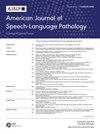患者的嗓音治疗动机在接受刺激性测试后会增强:嗓音治疗动机和嗓音感知量表的验证。
IF 2.3
3区 医学
Q1 AUDIOLOGY & SPEECH-LANGUAGE PATHOLOGY
引用次数: 0
摘要
目的测量患者对嗓音治疗的积极性是确定预后和估计依从性的重要组成部分。嗓音刺激性测试被认为可以通过改善患者对声音和/或嗓音感觉的感知来影响患者的治疗动机。本研究的目的是验证嗓音治疗动机和嗓音感知量表,并确定嗓音刺激性测试是否能改善患者的治疗动机和患者感知到的嗓音状态。方法75名接受初次嗓音治疗评估的患者填写了一份包含四个项目的量表,询问他们对嗓音治疗的承诺、通过嗓音治疗改变嗓音的信心、对嗓音严重程度的感知以及对嗓音努力程度的评价。问卷分别在刺激性测试前后完成。我们对调查问卷进行了心理计量分析,包括问卷中每一结构的内部一致性以及内容效度、预测效度和并发效度。我们还进行了配对样本统计分析,以确定刺激性测试前后的差异,并对嗓音和动机评分之间的斯皮尔曼相关性进行了分析,以确定患者对自己嗓音的感知与嗓音治疗动机之间的关系。动机量表可预测嗓音治疗疗程的复诊情况、第一次治疗疗程后嗓音的主观改善情况以及患者进行家庭练习的可能性。患者对嗓音严重程度和努力程度的评分与临床医生对总体严重程度的评分呈正相关。在进行可刺激性测试后,患者的动机和嗓音受损感都有所改善。结论嗓音刺激性测试可影响患者对嗓音治疗的积极性和患者对嗓音改善的感知。它应被视为嗓音评估的重要组成部分。本文章由计算机程序翻译,如有差异,请以英文原文为准。
Patient Motivation for Voice Therapy Increases After Stimulability Testing: Validation of a Voice Therapy Motivation and Voice Perception Inventory.
OBJECTIVE
Measuring patient motivation for voice therapy is an important component of determining prognosis and estimating compliance. Voice stimulability testing is assumed to influence the patient's motivation by improving their perception of the sound and/or feel of the voice. The purpose of this study was to validate a Voice Therapy Motivation and Voice Perception Inventory and to determine whether stimulability testing elicits improvements in motivation and patient-perceived voice status.
METHOD
Seventy-five patients who underwent initial voice therapy evaluation completed a four-item inventory that queried their commitment to voice therapy, confidence that they could change their voice through voice therapy, perception of their voice severity, and ratings of their vocal effort. Inventories were completed shortly before and after stimulability testing. A psychometric analysis of the survey was conducted, including the internal consistency of each construct of the inventory along with content, predictive, and concurrent validity. Paired-samples statistical analyses were conducted to determine differences before and after stimulability testing, and Spearman correlations between voice and motivation ratings were conducted to determine relationships between the patient's perception of their voice and their motivation for voice therapy.
RESULTS
Internal consistency reliability was acceptable to good for each construct, particularly after stimulability testing. Motivation scales were predictive of returning for voice therapy sessions, subjective improvement of voice by the first therapy session, and likelihood of the patient practicing the home practice program. Patient ratings of voice severity and effort were positively correlated with clinician ratings of overall severity. Motivation and voice impairment perception improved following stimulability testing. Reduction in vocal effort was related to improved motivation, but change in voice severity was not.
CONCLUSIONS
Voice stimulability testing can influence patient motivation for voice therapy and patient-perceived voice improvements. It should be considered a critical part of the voice evaluation.
求助全文
通过发布文献求助,成功后即可免费获取论文全文。
去求助
来源期刊

American Journal of Speech-Language Pathology
AUDIOLOGY & SPEECH-LANGUAGE PATHOLOGY-REHABILITATION
CiteScore
4.30
自引率
11.50%
发文量
353
审稿时长
>12 weeks
期刊介绍:
Mission: AJSLP publishes peer-reviewed research and other scholarly articles on all aspects of clinical practice in speech-language pathology. The journal is an international outlet for clinical research pertaining to screening, detection, diagnosis, management, and outcomes of communication and swallowing disorders across the lifespan as well as the etiologies and characteristics of these disorders. Because of its clinical orientation, the journal disseminates research findings applicable to diverse aspects of clinical practice in speech-language pathology. AJSLP seeks to advance evidence-based practice by disseminating the results of new studies as well as providing a forum for critical reviews and meta-analyses of previously published work.
Scope: The broad field of speech-language pathology, including aphasia; apraxia of speech and childhood apraxia of speech; aural rehabilitation; augmentative and alternative communication; cognitive impairment; craniofacial disorders; dysarthria; fluency disorders; language disorders in children; speech sound disorders; swallowing, dysphagia, and feeding disorders; and voice disorders.
 求助内容:
求助内容: 应助结果提醒方式:
应助结果提醒方式:


